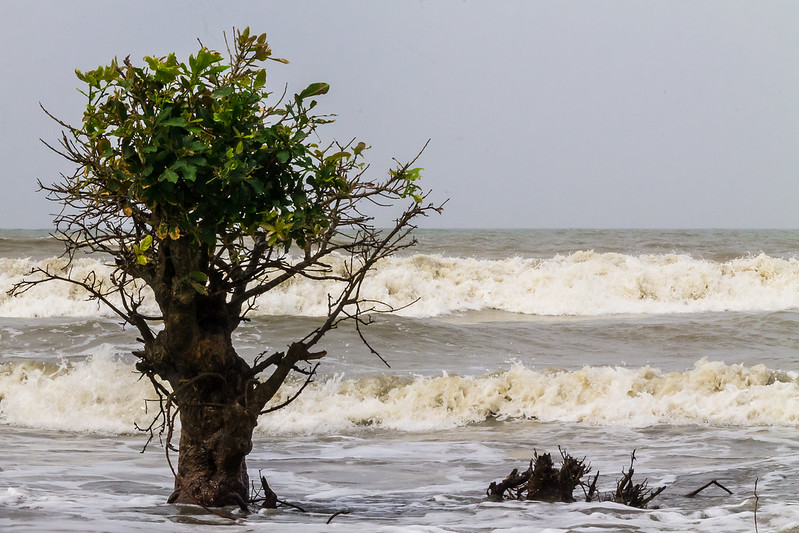國際研究團隊指出,維持地球運作的9大系統中,有4項已經遭人類活動嚴重破壞,越過了「地球限度」(planetary boundaries)。
18位科學家16日在《科學》期刊上發表研究「地球限度:變動地球上的人類發展指引」(“Planetary Boundaries: Guiding human development on a changing planet”),指出,調控地球韌性的系統正在變化,並可能影響目前或未來的人類社會。
升溫2℃不能殺價 臨界值之後就是崩壞
地球限度指的是引發不可逆、突發環境變化的臨界值。超過這些臨界值,將造成地球系統不穩定,形成當前和未來社會的風險。地球系統包括土地、海洋、大氣、冰層、生物和人類之間的複雜互動。
科學家主張,氣候變遷、生物圈完整性喪失、土地系統變遷以及磷和氮流失等生物地球化學循環改變,都已超過讓人類安居的臨界值。
「超過這些限度,人類活動將讓地球這個生態系統更不利人居,消弭貧窮的努力將徒勞無功、全球各地的生活條件惡化,包括富裕國家在內。」主要作者、斯德哥爾摩大學斯德哥爾摩韌性研究中心和澳洲國家大學學者Will Steffen說。
氣候變遷和生物圈完整性是其中最核心的地球限度。這兩個限度各自都足以讓地球系統徹底改變,不管是使之永續或是徹底崩壞。
作者警告,國際共識的2℃暖化臨界值,其實超過了氣候變遷這個地球限度,對人類來說還是有相當的風險,因此也應是國際氣候談判的最低目標。
氮磷循環改變 乾淨糧食、飲水取得增風險
另一個受人類活動影響的限度是氮磷循環。氮磷循環是地球上所有生命不可或缺的過程,在糧食和乾淨水源的生產上扮演重要角色。
負責氮磷循環篇章的作者、麥基爾大學環境學院Elena Bennett教授指出,氮肥和磷肥的使用,改變了生物地球化學循環,也帶來風險。
「人類依賴糧食,而糧食生產依賴乾淨的水源。但研究結果顯示,未來取得乾淨水源,用於生產糧食、飲用和游泳的能力可能受影響。」
其中一個問題在於,人類用來施肥的磷是有限的,而且集中在特定地理區域。近90%的磷集中在3個國家:摩洛哥、中國和阿爾及利亞。此外,人類施於土壤的磷肥流入湖泊,導致周邊水域的藻類大量增生,藻類產生對人類和其他動物有毒的物質,並造成其他生物減少或死亡。
「去年夏天,托萊多市50萬居民發現他們使用的自來水被微囊藻毒素污染。2007年魁北克政府宣布,超過75處湖泊被藍綠藻產生的毒素污染。這樣的問題會越來越頻繁,越來越多湖泊會被關閉。人們需要花更多心力和金錢淨化水源,越來越常發生無水可飲用的情況。這就是跨越地球限度的後果。」Bennett說。
9大地球限度
地球限度概念首次發表於2009年,科學家找出9大受人類活動影響的地球限度:
- 氣候變遷
- 生物圈完整性改變、生物多樣性喪失、物種滅絕
- 臭氧破壞
- 海洋酸化
- 生物地球化學循環改變
- 土地系統改變
- 乾淨水源使用
- 大氣中氣膠濃度、影響氣候和生物的大氣微粒
- 新物質的引進,如有機污染物、放射物質、奈米物質和塑膠微粒
Human activities have "dangerously compromised" four of the nine processes that are crucial to maintaining the stability of the planet, warns an international team of researchers .
In a study published online today, the 18 authors, from universities and research institutes around the world, provide new evidence of changes to the systems which regulate the resilience of the Earth, placing current and future societies at risk.
Climate change, the loss of biosphere integrity, land-system change, and altered biogeochemical cycles such as phosphorus and nitrogen runoff have all passed beyond levels that put humanity in a "safe operating space," the scientists report.
Their study fixing new "planetary boundaries" was published today in the journal "Science." The boundaries represent thresholds or tipping points beyond which there will be irreversible and abrupt environmental change.
Crossing boundaries raises the risks to current and future societies of destabilizing the Earth System – the complex interactions of land, ocean, atmosphere, ice sheets, life and people.
"Transgressing a boundary increases the risk that human activities could inadvertently drive the Earth system into a much less hospitable state, damaging efforts to reduce poverty and leading to a deterioration of human well-being in many parts of the world, including wealthy countries," said lead author Will Steffen from the Stockholm Resilience Centre at Stockholm University and the Australian National University, Canberra.
The report, an update to previous studies, is titled "Planetary Boundaries: Guiding human development on a changing planet."
Two core boundaries – climate change and biosphere integrity – have been identified, each of which has the potential on its own to drive the Earth system into a new state should they be substantially and persistently transgressed, warn the study’s authors.
The internationally agreed upper climate change limit of two degrees Celsius above the planetary temperature in pre-industrial times lies beyond the climate change boundary, the authors warn.
This "makes two degrees a risky target for humanity, and therefore an absolute minimum target for the global climate negotiations," they say.
One of the affected systems is the nitrogen-phosphorus cycle, which is essential to all life and important to food production and clean water.
Altered biogeochemical cycles from the use of fertilizers such as phosphorus and nitrogen is risky, warns Professor Elena Bennett from McGill University’s School of the Environment in Montreal, who contributed the research on the nitrogen-phosphorus cycle.
"People depend on food, and food production depends on clean water," said Bennett. "This new data shows that our ability both to produce sufficient food in the future and to have clean water to drink and to swim in are at risk."
One of the problems is that phosphorus, used as a fertilizer for fields and lawns, is in limited supply, and that supply is geopolitically concentrated, explains Bennett. Nearly 90 percent of all known phosphorus reserves are found in just three countries – most of it in Morocco, with the rest in China and Algeria.
Further, the excess of phosphorus-based fertilizers that drain from fields and lawns into neighboring lakes can have disastrous effects on the surrounding water. It can lead to the sudden growth of algae that can cause the decline or death of other lake organisms and produce toxins that are dangerous to people or animals that swim in the lake or get drinking water from it.
"About half a million residents of the city of Toledo found out that their tap water had been contaminated with a toxin called microcystin last summer. And in 2007 the Quebec government declared that more than 75 lakes were affected by toxins produced by blue-green algae," said Bennett.
"This kind of problem is likely to become much more common. We will see more lakes closed, will have to pay more to clean our water, and we will face temporary situations where our water is not cleanable or drinkable more and more frequently," she warned. "That’s what it means to have crossed this planetary boundary."
The planetary boundaries concept, first published in 2009, identifies nine global priorities relating to human-induced changes to the environment.
The nine planetary boundaries are:
- Climate change
- Change in biosphere integrity, biodiversity loss and species extinction
- Stratospheric ozone depletion
- Ocean acidification
- Biogeochemical flows
- Land-system change
- Freshwater use
- Atmospheric aerosol loading, microscopic particles in the atmosphere that affect climate and living organisms
- Introduction of novel entities, such as organic pollutants, radioactive materials, nanomaterials, and micro-plastics.
※ 全文及圖片詳見:ENS








